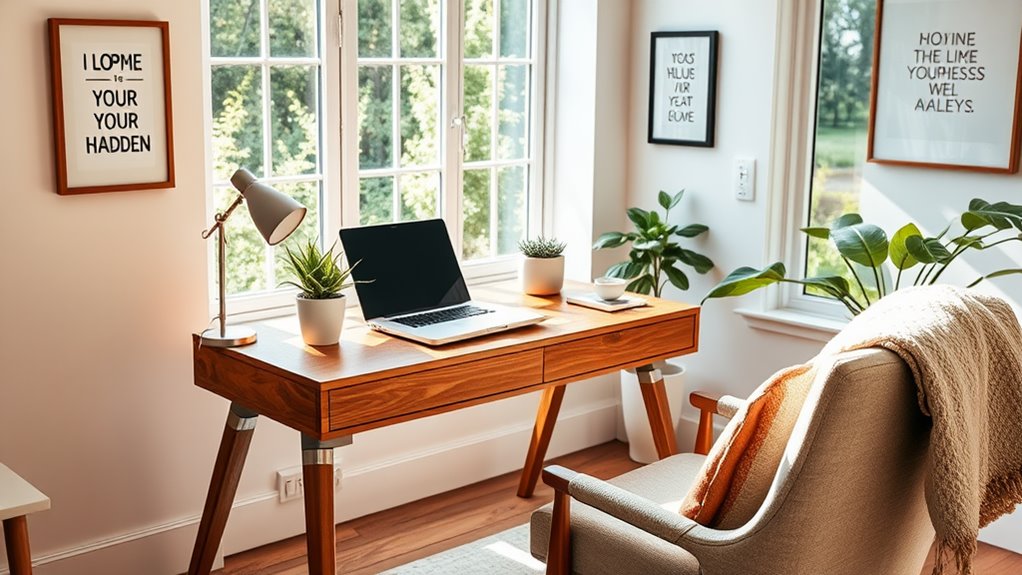Work-from-Home Tips Only the Pros Know About
To work from home like a pro, start by setting up a dedicated workspace free from distractions. Establish clear work hours and stick to a routine that aligns with your energy levels. Use time management techniques like the Pomodoro method to keep you focused, and don’t forget to schedule regular breaks to recharge. Minimize distractions by silencing notifications and creating “do not disturb” hours. Leverage technology tools for collaboration and project management, and build a support network for motivation. These insider tips can elevate your home work experience, and there’s even more to explore to enhance your productivity.
Key Takeaways
- Create a dedicated workspace that is organized, clutter-free, and equipped with ergonomic furniture to improve focus and productivity.
- Establish structured work hours and routines, aligning tasks with your natural energy levels for optimal efficiency.
- Use time management techniques like the Pomodoro Technique to enhance focus and prevent burnout through regular breaks.
- Leverage collaboration tools and automation software to streamline communication and reduce repetitive tasks, maximizing productivity.
- Build a support network with peers and online communities for motivation, accountability, and professional growth through regular check-ins.
Establish a Dedicated Workspace
Creating a dedicated workspace is vital for maintaining focus and productivity while working from home. When you set up a specific area just for work, you signal to your brain that it’s time to be productive.
Start by evaluating your environment—look for a quiet corner with minimal distractions.
Next, prioritize workspace organization. Keep your desk clutter-free and make certain that all necessary tools are within arm’s reach. Use organizers or drawer systems to streamline your materials, so you can easily locate what you need without derailing your focus.
An ergonomic setup is also essential. Invest in a chair that supports your back and maintain proper posture at your desk. Your computer screen should be at eye level to prevent strain, and your keyboard should be positioned so your wrists are straight.
Don’t overlook lighting; natural light can boost your mood and enhance alertness. If that’s not an option, opt for adjustable desk lamps with soft, warm light.
Set Clear Work Hours
Setting clear work hours is essential for maintaining productivity while working from home.
By establishing consistent start times and defining end-of-day rituals, you create a structured routine that helps you stay focused.
Don’t forget to communicate your availability to colleagues, so everyone knows when to reach you and when you’re off the clock.
Establish Consistent Start Times
Establishing consistent start times for your workday can considerably enhance your productivity and work-life balance. When you set a fixed time to begin your day, you’re not just signaling to yourself that it’s time to work; you’re also creating a powerful anchor in your morning routines. This ritual helps condition your brain to shift into work mode more effectively.
To make this work for you, consider implementing productivity hacks that align with your natural energy levels. For example, if you know you’re most alert in the morning, start your workday early. Conversely, if you hit your stride later, adjust accordingly. Whatever your choice, stick to it. Consistency is key.
Moreover, communicate your start times to colleagues and family. This helps create boundaries, ensuring fewer interruptions and distractions. You’ll find that having a defined start time can reduce decision fatigue, allowing you to focus on what truly matters.
Finally, don’t underestimate the importance of your pre-work routine. Engaging in a brief activity, like meditation or exercise, can set a positive tone for the day, enhancing your overall productivity.
Define End-of-Day Rituals
As important as it’s to start your workday with intention, defining end-of-day rituals can be equally beneficial for maintaining productivity and work-life balance.
Setting clear work hours isn’t just about clocking in and out; it’s about creating a structured shift from work to personal time.
Incorporating reflection techniques into your evening routine can greatly enhance this shift. Take a few minutes to review your accomplishments, jotting down what you achieved and what you plan to tackle tomorrow. This not only helps you wrap up your tasks but also provides clarity for the next day, reducing stress.
Consider establishing a physical ritual, such as shutting down your computer and tidying your workspace. This signals to your brain that the workday is done.
You might also want to incorporate some form of relaxation, whether it’s a short walk, a quick workout, or even meditation.
Communicate Availability Clearly
Clear communication about your availability is essential for both productivity and collaboration when working from home. Setting clear work hours allows your team to know when you’re reachable, which helps in managing expectations and reducing interruptions.
Start by establishing your core work hours and communicate your availability status using various communication tools like Slack or Microsoft Teams. Update your status regularly—if you’re in a meeting or taking a break, make sure that information is visible to your colleagues. This avoids unnecessary pinging and allows everyone to respect each other’s time.
Consider creating a shared calendar that reflects your work hours and any planned time off. This transparency not only enhances accountability but also fosters a culture of respect for everyone’s time.
Don’t forget to communicate any changes in your schedule proactively. If you need to adjust your work hours due to personal commitments, let your team know as soon as possible. By doing so, you’ll not only enhance collaboration but also position yourself as a reliable team member who values effective communication.
Use Time Management Techniques
Managing your time effectively while working from home can make all the difference in your productivity. Two popular techniques you should consider are the Pomodoro Technique and Time Blocking.
The Pomodoro Technique involves working for 25 minutes straight, followed by a 5-minute break. This method not only helps maintain focus but also combats mental fatigue. After four Pomodoros, take a longer break of 15-30 minutes. By structuring your work this way, you’ll find it easier to engage with tasks and maintain peak efficiency.
On the other hand, Time Blocking requires you to schedule specific blocks of time for different tasks throughout your day. By assigning clear time slots for each activity, you eliminate decision fatigue and create a roadmap for your workday. This technique is particularly useful for managing larger projects or balancing multiple responsibilities.
Experiment with these techniques to see which resonates best with your workflow. Remember, mastering time management isn’t just about fitting more into your day; it’s about creating a sustainable routine that enhances your overall productivity and well-being.
Start applying these strategies today, and watch your efficiency soar!
Minimize Distractions Effectively
Even with solid time management techniques in place, distractions can still derail your productivity when working from home. To combat this, start by identifying your biggest distractions. Is it social media, household chores, or maybe even family interruptions?
Once you know what pulls you away from your tasks, you can implement effective focus techniques to minimize these disruptions. Consider scheduling specific “do not disturb” hours where you communicate to others that you’re unavailable. During this time, silence notifications and engage in a digital detox—step away from screens that distract you.
You might also find it helpful to create a dedicated workspace that’s solely for work, free from clutter and distractions. Additionally, set a timer for focused work sessions, such as the Pomodoro Technique, where you work for 25 minutes and then take a 5-minute break.
This structured approach not only boosts productivity but also helps keep your mind sharp. Finally, practice mindfulness or meditation to enhance your concentration skills, allowing you to stay in the zone longer.
With these strategies, you’ll build a more distraction-free work environment and maximize your productivity.
Leverage Technology Tools
Harnessing the power of technology can markedly enhance your work-from-home experience. By utilizing the right tools, you can improve your productivity and streamline communication.
Here are three essential categories to evaluate:
-
Remote Collaboration Tools: Platforms like Slack, Microsoft Teams, or Zoom can facilitate seamless communication with your colleagues. These tools help keep everyone connected, whether you’re brainstorming ideas or conducting virtual meetings.
-
Productivity Apps: Leverage apps like Trello, Asana, or Notion to organize your tasks and projects effectively. These applications allow you to prioritize your workload and track progress, ensuring you stay on top of your responsibilities.
-
Time Management Software: Reflect on using tools like Toggl or RescueTime to monitor how you spend your work hours. By identifying your most productive times and potential distractions, you can make informed adjustments to your routine.
Prioritize Regular Breaks
Taking regular breaks is key to maintaining your productivity when working from home.
Short breaks can refresh your mind and improve focus, so it’s important to find the right balance in break duration.
Whether it’s a quick stretch or a brief walk, incorporating effective activities during your breaks can make a big difference in your overall performance.
Benefits of Short Breaks
In the hustle and bustle of a work-from-home environment, prioritizing regular breaks can greatly enhance your productivity and overall well-being.
Short breaks provide you with the opportunity to recharge, refocus, and ultimately work more efficiently. Here are some benefits that come from taking those brief intermissions:
-
Enhanced Focus: Stepping away from your desk allows your mind to refresh, reducing fatigue and improving concentration when you return to work.
-
Increased Creativity: Engaging in creative break ideas, like doodling or taking a walk, stimulates your brain, fostering innovative thinking and problem-solving.
-
Improved Mood: Regular breaks can serve as effective mental reset techniques, lowering stress levels and promoting a positive mindset, which is essential for sustained productivity.
Effective Break Duration
Finding the right duration for your breaks can be just as important as taking them in the first place. Understanding break length is vital for maintaining productivity and focus throughout your workday. Research suggests that a 5 to 10-minute break every hour can keep your mind sharp and your energy levels high.
However, you might also find that longer breaks, around 20 to 30 minutes, after a solid block of work can be even more advantageous.
During these breaks, it’s important to engage in activities that truly refresh you. Simple stretching or a quick walk around your home can help reset your mind and body. You might also consider stepping away from screens entirely—try reading a few pages of a book or listening to music.
Keep in mind that the key is to experiment with different break lengths and activities to see what best enhances your focus and creativity. Track your productivity and adjust as needed, ensuring that your breaks serve their purpose effectively.
Mastering this balance won’t only improve your work-from-home experience but also elevate your overall performance.
Activities for Refreshing Mind
Regular breaks not only help maintain your productivity but also provide a perfect opportunity to revitalize your mind. Taking a few minutes away from your screen can reinvigorate your focus and creativity.
Here are three activities you can incorporate into your breaks:
-
Mindful Breathing: Spend five minutes practicing mindful breathing. Find a quiet spot, close your eyes, and take deep, intentional breaths. This simple exercise can reduce stress and clear your mind, allowing you to return to work with renewed energy.
-
Stretching or Light Exercise*: Engage in some *gentle stretches or a quick walk around your space. Movement boosts circulation and gets those endorphins flowing, making you feel more alert and ready to tackle your tasks.
-
Creative Hobbies: Dedicate a short break to a creative hobby you enjoy, like sketching, journaling, or playing a musical instrument. These activities stimulate your brain differently, offering a stimulating mental shift that can inspire new ideas.
Incorporating these activities into your routine can enhance your focus, creativity, and overall well-being, ensuring you stay at the top of your game while working from home.
Cultivate a Support Network
A strong support network can make all the difference when working from home. Surrounding yourself with a group of peers who understand the unique challenges of remote work fosters motivation and accountability. Seek out individuals who share your professional goals or interests; they can provide invaluable peer support during tough times.
Start by engaging in online communities related to your field. Platforms like LinkedIn or industry-specific forums are excellent networking opportunities. Participate in discussions, share insights, and don’t hesitate to reach out for advice or collaboration. Building these connections can lead to mentorship possibilities and even potential partnerships.
Additionally, consider scheduling regular check-ins with your support network. Whether it’s a weekly video call or a quick chat over coffee, maintaining these relationships helps keep you connected and motivated. Sharing your successes and challenges can lead to new ideas and solutions that you mightn’t have considered alone.
Ultimately, a well-nurtured support network not only enhances your work-from-home experience but also contributes to your professional growth. Don’t underestimate the power of connection; it’s a crucial component of thriving in a remote work environment.
Frequently Asked Questions
How Do I Stay Motivated While Working Alone at Home?
Staying motivated while working alone can be tough. Establish a self-care routine and utilize productivity hacks, like time-blocking or setting clear goals. These strategies’ll keep you focused, energized, and committed to your tasks.
What Should I Wear for a Video Conference?
Choosing your outfit for a video conference is like picking the right armor for battle. Aim for professional attire that blends with casual comfort; it’ll keep you looking sharp while feeling at ease. Confidence is key!
How Can I Handle Family Interruptions During Work Hours?
To handle family interruptions during work hours, set clear family boundaries and communicate your schedule. Use noise management techniques, like headphones or a quiet workspace, to minimize distractions and maintain focus on your tasks.
What Are the Best Practices for Virtual Team Meetings?
To guarantee productive virtual team meetings, prioritize agenda setting and adhere to meeting etiquette. Clearly outline topics, assign roles, and respect time constraints, fostering engagement and accountability among participants for a successful collaboration.
How Do I Maintain Work-Life Balance While Working From Home?
Did you know that 60% of remote workers struggle with boundaries? To maintain work-life balance, prioritize time management and set clear boundaries. Schedule breaks and define work hours to create a productive yet fulfilling environment.




